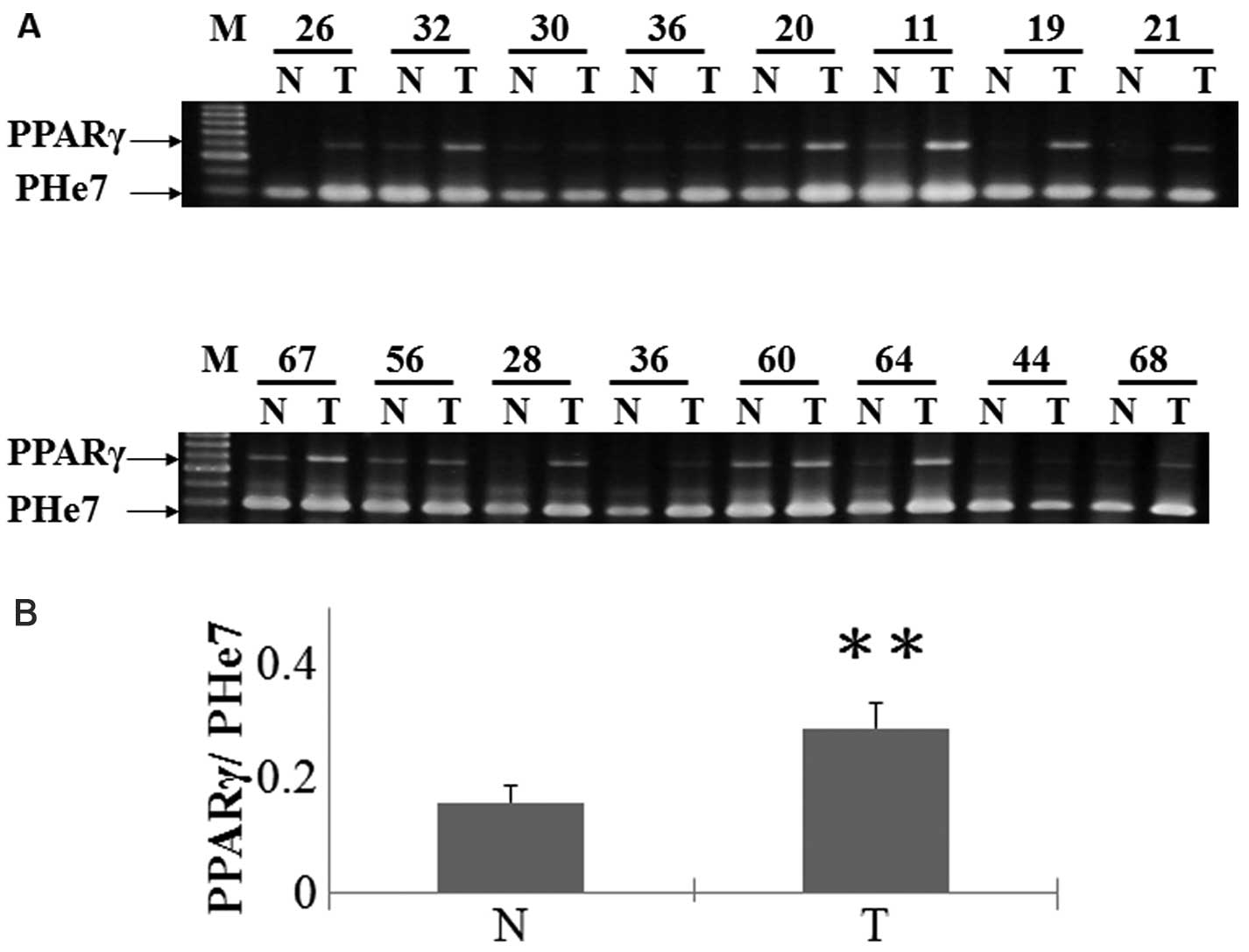|
1
|
Greten TF, Papendorf F, Bleck JS, et al:
Survival rate in patients with hepatocellular carcinoma: a
retrospective analysis of 389 patients. Br J Cancer. 92:1862–1868.
2005. View Article : Google Scholar : PubMed/NCBI
|
|
2
|
El-Serag HB: Hepatocellular carcinoma:
recent trends in the United States. Gastroenterology. 127:S27–S34.
2004. View Article : Google Scholar : PubMed/NCBI
|
|
3
|
Weng CJ, Chau CF, Hsieh YS, Yang SF and
Yen GC: Lucidenic acid inhibits PMA-induced invasion of human
hepatoma cells through inactivating MAPK/ERK signal transduction
pathway and reducing binding activities of NF-κB and AP-1.
Carcinogenesis. 29:147–156. 2008.PubMed/NCBI
|
|
4
|
El-Serag HB, Mason AC and Key C: Trends in
survival of patients with hepatocellular carcinoma between 1977 and
1996 in the United States. Hepatology. 33:62–65. 2001. View Article : Google Scholar : PubMed/NCBI
|
|
5
|
Vacca M, Degirolamo C, Massafra V, et al:
Nuclear receptors in regenerating liver and hepatocellular
carcinoma. Mol Cell Endocrinol. 368:108–119. 2012. View Article : Google Scholar : PubMed/NCBI
|
|
6
|
Koeffler HP: Peroxisome
proliferator-activated receptor γ and cancers. Clin Cancer Res.
9:1–9. 2003.
|
|
7
|
Vanden Heuvel JP: Peroxisome
proliferator-activated receptors (PPARS) and carcinogenesis.
Toxicol Sci. 47:1–8. 1999.PubMed/NCBI
|
|
8
|
Panigrahy D, Singer S, Shen LQ, et al:
PPARγ ligands inhibit primary tumor growth and metastasis by
inhibiting angiogenesis. J Clin Invest. 110:923–932. 2002.
|
|
9
|
Toyoda M, Takagi H, Horiguchi N, et al: A
ligand for peroxisome proliferator activated receptor γ inhibits
cell growth and induces apoptosis in human liver cancer cells. Gut.
50:563–567. 2002.
|
|
10
|
Wang X and Kilgore MW: Signal cross-talk
between estrogen receptor alpha and beta and the peroxisome
proliferator-activated receptor gamma1 in MDA-MB-231 and MCF-7
breast cancer cells. Mol Cell Endocrinol. 194:123–133. 2002.
View Article : Google Scholar
|
|
11
|
Foryst-Ludwig A, Clemenz M, Hohmann S, et
al: Metabolic actions of estrogen receptor beta (ERβ) are mediated
by a negative cross-talk with PPARγ. PLoS Genet.
4:e10001082008.
|
|
12
|
Wu X, Subramaniam M, Grygo SB, et al:
Estrogen receptor-beta sensitizes breast cancer cells to the
anti-estrogenic actions of endoxifen. Breast Cancer Res.
13:R272011. View
Article : Google Scholar : PubMed/NCBI
|
|
13
|
Ng IO, Ng M and Fan ST: Better survival in
women with resected hepatocellular carcinoma is not related to
tumor proliferation or expression of hormone receptors. Am J
Gastroenterol. 92:1355–1358. 1997.PubMed/NCBI
|
|
14
|
Jonas S, Bechstein WO, Heinze T, et al:
Female sex hormone receptor status in advanced hepatocellular
carcinoma and outcome after surgical resection. Surgery.
121:456–461. 1997. View Article : Google Scholar : PubMed/NCBI
|
|
15
|
Kennelly R, Kavanagh DO, Hogan AM and
Winter DC: Oestrogen and the colon: potential mechanisms for cancer
prevention. Lancet Oncol. 9:385–391. 2008. View Article : Google Scholar : PubMed/NCBI
|
|
16
|
Yu J, Shen B, Chu ES, et al: Inhibitory
role of peroxisome proliferator-activated receptor gamma in
hepatocarcinogenesis in mice and in vitro. Hepatology.
51:2008–2019. 2010. View Article : Google Scholar : PubMed/NCBI
|
|
17
|
Borbath I and Horsmans Y: The role of
PPARγ in hepatocellular carcinoma. PPAR Res. 2008:2095202008.
|
|
18
|
Li MY, Deng H, Zhao JM, Dai D and Tan XY:
Peroxisome proliferator-activated receptor gamma ligands inhibit
cell growth and induce apoptosis in human liver cancer BEL-7402
cells. World J Gastroenterol. 9:1683–1688. 2003.PubMed/NCBI
|
|
19
|
Lovat PE, Oliverio S, Ranalli M, et al:
GADD153 and 12-lipoxygenase mediate fenretinide-induced apoptosis
of neuroblastoma. Cancer Res. 62:5158–5167. 2002.PubMed/NCBI
|
|
20
|
Galbiati E, Caruso PL, Amari G, et al:
Pharmacological actions of a novel, potent, tissue-selective
benzopyran estrogen. J Pharmacol Exp Ther. 303:196–203. 2002.
View Article : Google Scholar : PubMed/NCBI
|
|
21
|
Chen GG, Lee JF, Wang SH, Chan UP, Ip PC
and Lau WY: Apoptosis induced by activation of
peroxisome-proliferator activated receptor-gamma is associated with
Bcl-2 and NF-kappaB in human colon cancer. Life Sci. 70:2631–2646.
2002. View Article : Google Scholar : PubMed/NCBI
|
|
22
|
Terashita Y, Sasaki H, Haruki N, et al:
Decreased peroxisome proliferator-activated receptor gamma gene
expression is correlated with poor prognosis in patients with
esophageal cancer. Jpn J Clin Oncol. 32:238–243. 2002. View Article : Google Scholar : PubMed/NCBI
|
|
23
|
Cui Y, Miyoshi K, Claudio E, et al: Loss
of the peroxisome proliferation-activated receptor gamma (PPARγ)
does not affect mammary development and propensity for tumor
formation but leads to reduced fertility. J Biol Chem.
277:17830–17835. 2002.
|
|
24
|
Yu J, Qiao L, Zimmermann L, et al:
Troglitazone inhibits tumor growth in hepatocellular carcinoma in
vitro and in vivo. Hepatology. 43:134–143. 2006. View Article : Google Scholar : PubMed/NCBI
|
|
25
|
Li MY, Hsin MK, Yip J, Mok TS, Underwood
MJ and Chen GG: PPARgamma activation extinguishes smoking
carcinogen by inhibiting NNK-mediated proliferation. Am J Respir
Cell Mol Biol. 42:113–122. 2010. View Article : Google Scholar : PubMed/NCBI
|
|
26
|
Badawi AF and Badr MZ: Expression of
cyclooxygenase-2 and peroxisome proliferator-activated receptor-γ
and levels of prostaglandin E2 and
15-deoxy-Δ12,14-prostaglandin J2 in human
breast cancer and metastasis. Int J Cancer. 103:84–90. 2003.
|
|
27
|
Sakamoto A, Yokoyama Y, Umemoto M, et al:
Clinical implication of expression of cyclooxygenase-2 and
peroxisome proliferator activated-receptor gamma in epithelial
ovarian tumours. Br J Cancer. 91:633–638. 2004.PubMed/NCBI
|
|
28
|
Upla P, Marjomaki V, Kankaanpaa P, et al:
Clustering induces a lateral redistribution of α2β1 integrin from
membrane rafts to caveolae and subsequent protein kinase
C-dependent internalization. Mol Biol Cell. 15:625–636. 2004.
|
|
29
|
Bonofiglio D, Gabriele S, Aquila S, et al:
Estrogen receptor α binds to peroxisome proliferator-activated
receptor response element and negatively interferes with peroxisome
proliferator-activated receptor γ signaling in breast cancer cells.
Clin Cancer Res. 11:6139–6147. 2005.
|













